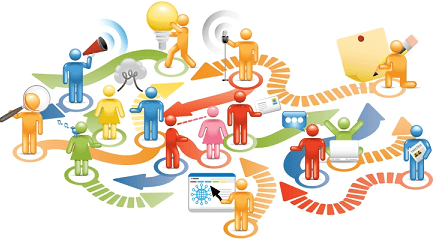
If you were like me and heard the phrase, "business ecosystem and innovation," your eyes either rolled in their sockets, or your vision suddenly became blurry. You more than likely thought to yourself, "Oh heavens, yet another person who's trying to sound sophisticated," or "do I really want to enter down this rabbit hole? Is it going to be worth it?" I assure you it isn't as bad as it sounds. In fact, the research I conducted got me thinking a lot. It's worth reading on.
A business ecosystem is a set of businesses or other actors that have resources and act together competitively or cooperatively to form a unique independent system. Examples of business ecosystems in technology include platform-based ecosystems (Apple or Google), start-up ecosystems (Udemy, Remind, or Canvas ), and mobility ecosystems (Uber or Lyft). 3 characteristics of business ecosystems include: sustainability, self-governance, and innovation. The impact of these characteristics on an industry can provides additional insights; such as, short and long-term viability and future strategic initiatives. The better you understand your business ecosystem the more prepared you are to effect positive changes and growth.
SUSTAINABILTY
Generally, the term sustainability refers to meeting the needs of the present without sacrificing the needs of the future. Within the context of business ecosystems, sustainability occurs when the needs of entrepreneurs: who use resources, do not impede the needs of future entrepreneurs. In this case resources are either used and replenished or reused.
The three types of business ecosystems listed above are examples of sustainable ecosystems. Since these are technology companies, their resources consist of computer hardware, and human capital (programmers, sales, support etc.). Given the current state of computer hardware there appears to be a near endless supply. Depending on advances in technology, the sustainability of computer hardware could change, but at this time that does not seem likely. Conversely, access to human capital capable of sustaining these businesses is in good supply, and will likely remain so for the foreseeable future.
If you are involved in a business ecosystem that is not sustainable, that fact is more than likely an important factor in your present day decisions as they relate to future strategic initiatives. The amount of time remaining before resources are no longer available becomes paramount. Either you prepare to exit the business ecosystem, or you determine ways to become more sustainable.
Becoming more sustainable may involve innovation to use fewer resources or differentiation of resources. You could also enact predatory practices to "kill off" your competition and acquire a larger percentage of the remaining resources.
In any case, this is why it is imperative to understand the sustainability of your business ecosystem. A company who understands these dynamics first has a competitive advantage over other companies. Moreover, you could use this information to prepare yourself from "bad" or "predatory" actors.
A real world example of a dying business ecosystem is the "Mainstream Media." Mainstream media refers to news organizations that provide information via television. With an average viewer age in the 60's and a younger population that watches television very seldomly, these companies are facing the extinction of their viewers. They can innovate by connecting with younger viewers, or they can predicate other networks by stealing viewers. Mainstream media will have to innovate or die off eventually.
SELF-GOVERNANCE
Self-governance is defined as no hierarchical control. A business ecosystem that enjoy a high degree of self-governance isn't lawless. There may well be a shared set of norms most actors choose to follow. There will also be competing rules or standards that are dynamic and continuously evolving, augmenting and changing.
A healthy business ecosystem will display a good degree of self-governance. The absence of self-governance is oftentimes restrictive and restricts innovation.
Going back to our previous example of technology companies, platforms such as Google and Apple represent a low degree of self-governance. Entrepreneurs have used these platforms to make a plethora of new "apps" or applications for mobile phones, and they have done quite well.
How is this an example of low self-governance?
To develop for these platforms you must use a narrow range of programming languages, there are restrictions on the size of apps, functionality of apps, and as a developer you are at the mercy of one companies promotion algorithm. Overnight, due to changes in the rules or standards, your business and more importantly, your livelihood could vanish.
As a developer for one of these platforms, your level of self-governance is severely restricted. Furthermore, there is no incentive to think outside the box, other than trying to create an app that has not already made. The box is limiting and it hinders ongoing innovation.
INNOVATION
The last characteristic of business ecosystems is innovation or evolution. In competitive ecosystems innovation thrives. Actors are able to innovate through experimentation. Research and development is an example of innovative techniques. Any method or action that brings about a positive change in the status quo is a positive innovation.
If self-governance is high, future growth is sustainable, and competition is established. In this scenario there will be a need and desire to innovate.
In a perfectly competitive industry there is zero economic profit. This means there are no barriers to entry along with a slew of other conditions, and actors move into the ecosystem because there were profits thereby moving the price for products or services to a "point of equilibrium." When an industry is perfectly competition and hits "the point of equilibrium," there are no profits. All inputs are paid for. All members of the system are paid. There is no extra surplus or profit.
Therein lies the desire to innovate!

In the real world, companies have different operating costs, varied skill levels, and do not operate identical to one another. When an actor assesses their strengths and weaknesses, as they related to the business ecosystem, they are able to strategically allocate their resources to attain the highest level of competition available to them.
For example, if Company B realises it is being outperformed by Company A because Company A has better skilled workers, Company B can hire better skilled workers or implement robotic automation to boost its output to that of Company A. In this case, innovation led to the success of Company B.
Since the real world is never perfectly homogenous, there are many ways to achieve a competitive advantage, especially if innovation is possible. But don't forget, innovation is only possible under conditions of sustainability and self-governance.
Favourable conditions of these three characteristics are witnessed for start-up and mobility ecosystems. Both of these technology industries are sustainable due to the nature of technology, they are relatively new and have not undergone excessive regulation, and allow for a great deal of evolution or innovation.
How our examples of technology companies fair against the three business ecosystems characteristics can be viewed in the table below.

A NOTE ABOUT GOVERNANCE
There is debate over the application of governance. Economic capitalists argue against most forms of self-imposed governance. Economic socialists argue for governance; seeing the state and its bureaucracies as the moral arbiter of social welfare and fairness. Those are notably two extremes. As with most things, a centrist opinion may be worthy of attention.
Let's add a little context. Recently the technology giants have faced criticism regarding personal data; more specifically, who owns the data? and can the data be used to generate revenue? Initially, let's say ten years ago, there was little desire for regulation, instead, companies were allowed to expand and grow their influence. Social media was so new and unknown, no one knew what to expect. They didn't know the end game. They didn't fully understand their influence.
In the United States of America these business ecosystems are increasingly competing with the notion of free speech (1st amendment to the constitution). Additionally, these platforms have a monopoly on the access to information. With more and more people choosing to get their information from alternative media sources, the power and influence of these technology companies rivals that of mainstream media and the government.
There is potential for serious abuses.
A centrist approach to fostering good governance includes:
- implement a rating system ( attempt to diminish bias in favor of collective consideration )
- governments need to work with 3rd party regulatory actors that understand the business ecosystem well
- governments to appoint super-regulators that work under a set of core values ( privacy and security ) to enact regulations that are sustainable, promote good governance, and allow for continued innovation
Therefore, a required level of privacy, security and personal liberty is maintained for the masses without stifling the well-being of these burgeoning companies. Give them a long leash, but choke them with it if they try to bite you.
STRATEGIC INITIATIVES OR POSITIONING
The three characteristics of business ecosystems are like actors in a play. All must be provisioned perfectly. Too much from one, or not enough from another will affect the quality of the play.
This is why the use of the term, "ecosystem" is so perfect.
Ecosystems are wondrous in their complexity but wonder oftentimes masks delicacy. If you fully comprehend your business ecosystem, you have insights into what makes it wondrous and what makes it delicate. You can use this insight to your advantage. You can position your business to be more competitive or predatory. You can determine when it is time to leave an ecosystem or pass on one.
A prime example of a changing ecosystem and taking advantage of that change is the cloud. Many businesses are contemplating moving their data infrastructure to the cloud. 5 years ago this change would be laughable. Now, companies that fail to act are in danger of being left behind.
Every business ecosystem is different. You won't be able to attribute the lessons learned from one to another. Not perfectly. Understanding the characteristics of a business ecosystem, their interconnectedness, and subtleties, will help you establish future strategic initiatives and ensure your positioning will most likely be favorable.

THANKS TO THE SOURCES FOR THIS ARTICLE
Information Source: Mari Sako. (2018). Technology Strategy and Management: Business Ecosystems: How Do They Matter for Innovation? Communications of the ACM, 61(4), 20–22. doi:10.1145/3185780.
Infographic cover page image: Deloitte Insights
Now that we have taken a look at business ecosystems, are there any requests for follow up articles? I would be happy to research additional information. How might you use this information to influence your future strategic initiatives? Let us know.








